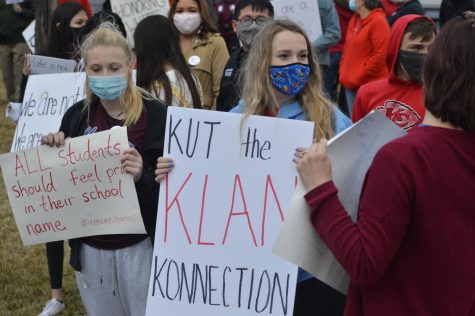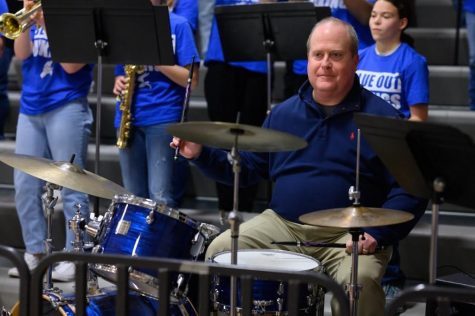Name change advisory board set to construct after district board meeting
The first in-person board meeting in three months held a domino sequence of events ending in the proposal of an advisory council to help make a name change decision by June 2022.
With a petition occurring mid-February to change the namesake of the Seaman School District, board members, alumni, community members, and students came out to speak their minds for just over an hour at the high school gym, plastered with the namesake.
Both sides brought strong arguments with support evenly split on both sides of the matter. Though each speaker formed a different argument, the belief which permeated throughout each speech was the district demand to find a way to move forward.
Protesters provide pushback to the board

Protestors posted in front of the high school at 5 p.m., just an hour before the board meeting, to show their support of a name change. However, they were quickly ushered down by officers between Rochester road and the North parking lot to resume their efforts due to the instruction of superintendent Steve Noble.
All attendees came from different walks of life which included current students, teachers, community members, alumni, students of fellow county schools, and Black Lives Matter members.
Supporters of the name change championed the event with a variety of messages on signs, stickers, buttons, and shirts in various shades of red, black, and blue.
Jay Vehige — an attendee from Emporia — was one of the protestors who worked time into their day to attend the event. In his time at the demonstration, he took the chance to mention a key Kansas figure who pushed back against the Klan such as the infamous William Allen White.
Vehige emphasized the significance of White’s influence and how “he could have been lynched, he could have been murdered” but nonetheless persisted in efforts to disband the Klan in running for the position of State Governor.
“That’s the type of energy we need to bring to this. The type of courageousness we need to bring to this,” he said. “When we look back at history, where were we?”
“What are they going to say about us?”
The board breaks a new discussion

First talks of the name began with the Board President James Adams as he released remarks early in the meeting before the public discussion to speak to the direction which possibly renaming Seaman would take.
Adams relayed that the barrage of feedback from the community has raised enough cause amongst the board to begin the discussion of a name change, heavily implying that the process should be considered rather than a singular outcome.
“Following tonight’s board meeting if consensus with the board is achieved,” said Adams. “I will be instructing Dr. Noble to create an advisory group that will be led by the Kansas Leadership Center to facilitate a community discussion to ensure all stakeholders have an opportunity to be heard and ultimately brought back for the board of education to take action.”
The notion for the advisory council was eventually approved, but not without a hefty number of speeches from the general public who held opinions on both sides of the spectrum.
The bulk of the first half of speeches rested on the idea of renaming the district. Arguments heavily revolved around the history of perpetuated racism within the district that the current EAN network is now trying to break down.
Junior Kevinh Nguyen reflected his individualism as a student with a Vietnamese background — making up one of the two percent of Asian-American student attendees — and the expense that the long-held lack of diversity within USD 345 school system has caused to him.
He revealed that he didn’t want incoming students to have struggles in the locker room, “the same locker room I was attacked (in) viciously because of my race, constantly, every day, before my practice,” until eventually quitting the team due to the damage on his mental health.
Seaman High School custodian Eric Snell, one of few African-American staffers at the high school, relayed his disgust with some of the things seen around the school.
”As a black man of 60, I have heard the n-word and seen it written on the bathroom stalls,” Snell said.
Yet, resistance came later on within the discussion surrounding the cost of changing the namesake, its spread through alumni memorabilia, and memories attached in such an endeavor as to rename the whole district.
Living in the district for ten years, with three kids graduating from the Seaman School District, Mikki Thurlow spoke to the monetary expense of having to change the name completely.
“I haven’t heard about anybody talking about the funds to do this, and I know you can’t put a price tag on it,” said Thurlow. “But the ugly truth is that we have to put a price tag on it.”
19666 alum Chris Hutton relayed that the change would reflect a difference from the apparel which former students still hold in their collections today.
“Let’s not blow up the whole ship just because Fred Seaman was a dummy. We need to leave the word Seaman on there. You guys don’t realize how many thousands of letter jackets are out there with some simple (patch) like that with Seaman on it,” said Hutton.
After public speeches came several board comments highlighting the detachment that the board has with the Ku Klux Klan and racism as a whole within its schools.
Board member Keith Griffin who emphasized his commitment to finding a way to move forward for the district.
“I denounce racism just as everyone else at this table does,” said Griffin. “I strongly support that we develop a process to identify how to heal this community.”
Frank Henderson, a long-time member on the board, put stress on his pride with the students pushing a process “whether you like it or not” to continue speaking about this issue.
He finished off the evening complimenting the students who took charge in the process to reveal information and push for a conversation.
“Our students are considering others besides themselves, it is not something to just benefit themselves,” said Henderson “I commend our students for being the ones that actually brought us to this place where we can decide on a process and begin those steps.“












